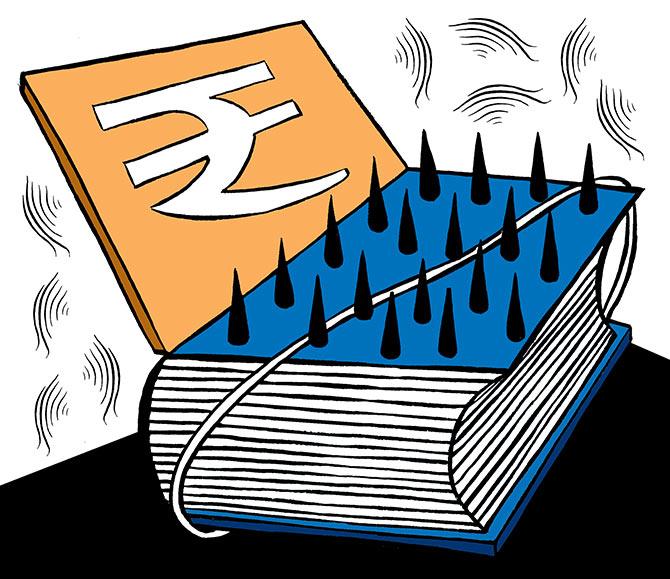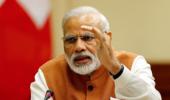Lower revenue collection puts upward pressure on government borrowing, ensuring that it deviates from the glided path of debt reduction
Illustration: Uttam Ghosh/Rediff.com

It is now increasingly looking unlikely that the Centre will be able to meet its targets for key macroeconomic variables for 2017-18, as detailed in the medium-term fiscal road map last year.
This, in turn, will impact the government’s ability to meet the 2018-19 targets as well.
First, economic growth has dipped in the current financial year.
It is unlikely to pick up sharply in FY19, as the economy struggles to deal with the twin shocks of demonetisation and the Goods and Services Tax (GST).
Second, a sluggish economy, coupled with the uncertainty under the new indirect tax regime and lower dividends from the Reserve Bank of India (RBI), will probably ensure that the government fails to meet its revenue target this year.
Failure to do so reduces the likelihood of the government sticking to its fiscal deficit target, unless expenditure is curtailed drastically.
Lower revenue collection, in turn, puts upward pressure on government borrowing, ensuring that it deviates from the glided path of debt reduction.
Growth slows down
Over the course of the past one year or so, economic activity in India has been severely disrupted due to demonetisation and the shift to the GST regime.
The Advance Estimates released by the Central Statistics Office (CSO) showed the economy was likely to grow at 9.5 per cent (current prices) in FY18.
In comparison, the government in its medium-tem outlook last year, had projected a growth rate of 11.75 per cent (current prices).
From a purely statistical standpoint, this 2.25 percentage point difference implies a deterioration in key fiscal metrics. Take, for example, the fiscal deficit.
If the government retains its Budget Estimate (BE) of Rs 5.5 trillion, the slower GDP growth would imply a deficit of 3.29 per cent of GDP, as opposed to 3.24 per cent earlier.
To put it differently, the government would have to reduce its absolute deficit by Rs 77.7 billion to keep it at 3.24 per cent of GDP.
The fiscal outlook had projected GDP to grow at 12 per cent in FY19 and FY20.
But given the state of the economy and a revival in investments unlikely in the near term, economists are sceptical of growth matching projections.
But if growth rises to 12 per cent in FY19, a deficit of 3 per cent works out to around Rs 5.58 trillion in FY19, marginally up from Rs 5.46 trillion in FY18. But at 10 per cent growth, even this limited extra room for greater public spending disappears.
However, if the government wants to boost public spending, it could keep its deficit at 3.2 per cent.
At 12 per cent nominal growth, this translates to a deficit of Rs 5.95 trillion, creating space for extra government spending of Rs 500 billion.
But at 10 per cent growth, the extra spending space falls to Rs 390 billion.
Revenue under pressure
On the revenue side, a slowing economy, lower dividends from the RBI and uncertainty under the GST has complicated the task of the government to meet its gross tax revenue target, which was budgeted at 11.3 per cent of GDP in FY18.
Corporate collections have held up so far. But personal taxes have grown by 15.3 per cent (April-November), against BE of 24.9 per cent, according to the figures released by the Controller General of Accounts.
For the target to be met, personal taxes would have to grow by a staggering 38.7 per cent in the remaining four months.
The bigger worry is indirect taxes. The government had expected indirect taxes to grow by 7.6 per cent in FY18 to Rs 9.27 trillion.
Headline indirect tax growth was 12.2 per cent in the first eight months of FY18.
But dig a bit deeper and the problems surface.
The headline number also includes collections on account of integrated GST (IGST), revenues from which have to be shared with the states.
Adjusting for states share, ICRA estimates indirect taxes to have contracted by 1.4 per cent till November this year, implying a huge gap in collections.
A back-of-the-envelope calculations suggest that indirect tax collections would need to grow by 32 per cent in Q4FY18 to meet the Budget target.
Sluggish growth is also likely to put the FY19 target of gross tax revenue of 11.6 per cent of GDP under pressure.
Then there’s also the shortfall on the non-tax revenue side, budgeted at 1.7 per cent of GDP.
Rathin Roy, director of the National Institute of Public Finance and Policy (NIPFP), has estimated the current non-tax revenue to be 0.53 per cent of GDP.
Part of the shortfall can be made up by higher proceeds from divestment.
Others have also suggested that greater dividends from the RBI and public sector undertakings would plug the gap.
But, as ICRA points out, “Non-tax revenues would need to expand by a considerable 84.6 per cent in the remainder of the fiscal year to meet the budgeted targets, which may be difficult to achieve without a significant pick-up in dividends from various PSUs.
There remains a risk of a moderate shortfall relative to the dividends and profits that the ICRA had budgeted for FY2018.”
Fiscal deficit worries
If revenues fall short of the target, the government will have two options - cut expenditure or deviate from the path of fiscal consolidation.
Pursuing the former will imply cuts on capital expenditure, as much of revenue expenditure is sticky in nature.
Capex would have to contract by 15.4 per cent in the last four months of this fiscal year, which would have negative implications for the investment cycle.
But if the government holds its expenditure, and revenues remain depressed, the deficit could shoot up.
Economists expect the government to breach the deficit ceiling.
“It now appears that the fiscal slippage is higher than our expectations, slipping by 50 bps (basis points) from the budgeted levels at about 3.7 per cent of GDP, to be essentially funded by dated securities and T-bill issuances,” say economists at Kotak Institutional Equities.
Worsening debt dynamics
To plug this shortfall in revenues, the government has announced additional borrowing of Rs 500 billion.
As a consequence, net market borrowings will rise from a budgeted Rs 4.23 trillion to Rs 4.73 trillion this year - the highest level since 2013-14.
One must also point out that this additional borrowing does not factor in the Rs 800 billion meant for bank recapitalisation.
While this is likely to be a below-the-line item and will not show up in the fiscal deficit, the amount will be added to debt of the government raising its debt-to-GDP ratio.
In comparison, in the medium-term fiscal framework, the government had projected the debt-to-GDP ratio to decline from 46.7 per cent in FY17 (RE) to 44.7 per cent in FY18 (BE) and further to 42.8 per cent in FY19.











